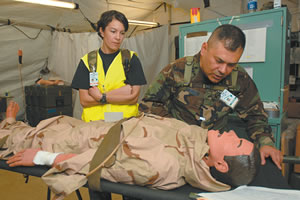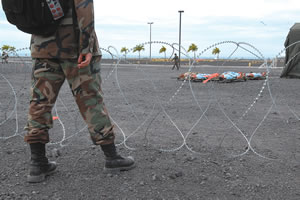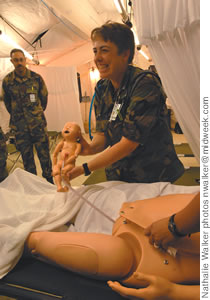IN CASE OF EMERGENCY
On a recent weekday, the tiny Pacific Island nation of Moku was struck by a super typhoon that left 2,000 dead, 2,000 more in need of medical attention and more than 50,000 homeless. Fortunately for the residents, airmen from bases in Guam, Hawaii, Alaska, Texas and Washington were on the ground within 24 hours to begin providing emergency medical care to the storm-battered island.

By .(JavaScript must be enabled to view this email address)
E-mail this story | Print this page | Archive | RSS

|
port the weight of the large aircraft, but inspecting roads, finding a suitable location for the camp and determining the availability of local resources that can be implemented to support the mission.
“There were no major problems,” said Oldham about the three C-17 Globemaster III’s and two C-5 Galaxies full of equipment that was assembled for the experiment. “With this much equipment, not every piece is going to work how you would like, but our guys were able to trouble-shoot and fix the problems.”
Of course, being scrambled to a Big Island airport made things a bit easier. Next time, the call may not be a drill.
“In a real-world environment, we would have the capability to see up to 1,000 patients per day if most of them were walk-ups with minor needs,” says Col. Nicholas Miniotis, commander of the 3rd Dental Squadron at Elmendorf Air Force Base, Alaska, and PACAF EMEDS commander during Pacific Lifeline.

|
“During the mass casualty exercise, we treated more than 200 simulated inpatients with severe and critical care needs over a 48-hour period. This included performing 10 general surgeries and delivering five babies, which is realistic to what we might see during a humanitarian event.”
Though the two-week exercise had its share of stumbles and minor problems, for all involved the operation was an unqualified success.
“Outstanding. You can’t ask for a better mission,” says Fielder. “It’s pretty nice to take our capabilities and take them somewhere and execute it. We are probably one of the only countries that can do airvacs in this number of people because of the air-lift capability we have.”

|
The major went on to say the benefits of humanitarian aid touch not just the patients but those providing the assistance as well.
“It’s a good feeling. There are a lot of children I’ve seen who have been treated in a lot of countries and have been flown out and treated, and to see the final results is pretty amazing. I think if you ask any medical person about the tasking, what they really enjoy going on - especially our providers, our doctors - is the humanitarian missions. They really feel they are taking their schools, the capabilities, their talent, and giving it to people who really need it.”
Page 2 of 2 pages for this story < 1 2
E-mail this story | Print this page | Comments (0) | Archive | RSS
Most Recent Comment(s):








